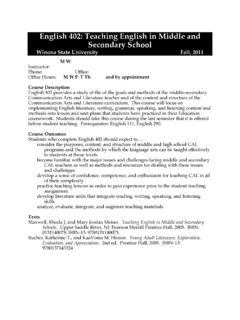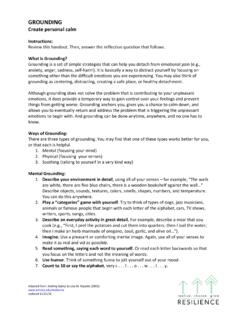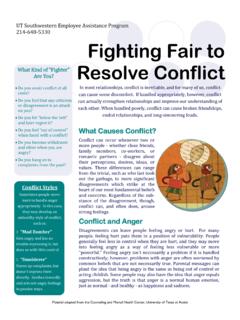Transcription of CONFLICT RESOLUTION - Winona State University
1 CONFLICT RESOLUTION How to effectively manage difficult conversations updated 2/28/2017 Instructions: This worksheet is designed to help you resolve CONFLICT through use of effective communication. Use it to guide your actions in a way that produces a peaceful solution in time of disagreement. First, let s take a look at the CONFLICT you are facing using the Stop-Think-Act model: 1. Stop! Breathe. Calm Down. Now, you are ready to accurately look at the problem at hand. 2. Think! Ask yourself: What exactly is the problem ? Is this really a problem ?
2 Why? It is my problem ? Does it need immediate attention? What do I want? What is my goal? What might I be assuming? What might be another person s point-of-view? What are my options? What are the potential consequences of each option? What is my best choice here? 3. Act! Take action and responsibility for that action Evaluate your action and the outcome. What can I learn from this? Does the problem still exist? If no, learn from your experience. If yes, start again Next, if you have determined that there is indeed a CONFLICT that needs to be resolved, here s some additional CLUES on how to resolve C - communicate promptly, assertively, respectfully.
3 Initiate a private conversation and share your perspective & goal. Remember, talk to people, not about people. L listen to the other person s point of view. Allow them to speak without interruption, hidden agenda or judgment. Then, reflect what you hear to clarify what they are saying. U understand their perspective. Practice empathy; Help me understand your point-of-view. Also, discuss one issue at a time, get the facts, and clarify assumptions. E - explore options & solutions. Brainstorm to generate options. Choose a solution that works for you both and act on it.
4 S - So, how did it go? Evaluate how it went. Then move one or plan next steps. What did you learn? CONFLICT RESOLUTION How to effectively manage difficult conversations updated 2/28/2017 Now, if you are still stuck wondering what to say in the face of CONFLICT , try Starting the conversion: I want to talk to you about something and I d appreciate it if you would first listen to what I have to say and then I will do the same for State the problem : I ve , I feel _____, Because _____, and What I want is _____ Gaining understanding: Help me understand (your view point, what s going on, what that s like for you).
5 Reflecting/Paraphrasing: What I hear you saying that correct? Move towards action: Given what we just talked about, what are some possible solutions that could work for us both? Finally, here are some CONFLICT RESOLUTION Dos & Don ts DO: Communicate face-to-face Manage your own emotions Use language that is understood Recognize and embrace differences Understand interests and perspectives of self and others Act sooner rather than later Focus on the present situation/ problem Actively listen and pay attention Be present, clear, and direct Be honest, genuine, and respectful Assert yourself Be aware of body language Convey the value of your relationship DON T.
6 Wait or avoid the issue Assume Get defensive Interrupt Ignore feedback Argue feelings, judge or criticize Use put-downs or sarcasm Rely solely on verbals or nonverbal Discuss the problem with others not associated with the issue Stop communicating
















